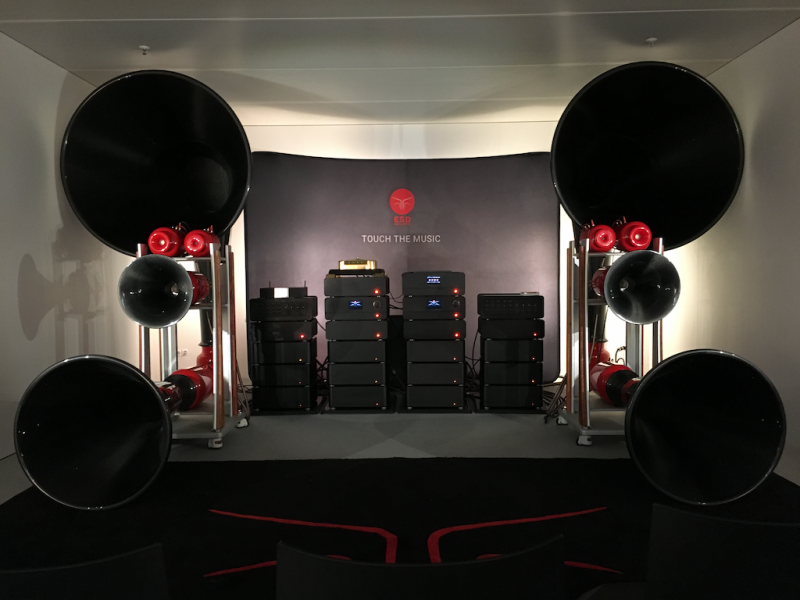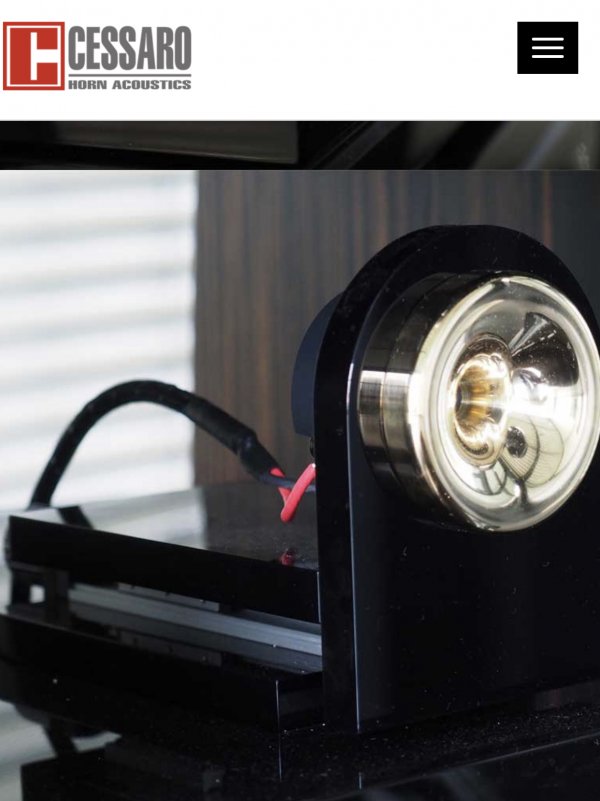Have you heard their big horn system?FYI, ESD Acoustics has several speaker models using Truextent Beryllium diaphragms with Field Coil magnets. In fact, they make six different drivers that use both.
( dragon or super dragon ).
Have you heard their big horn system?FYI, ESD Acoustics has several speaker models using Truextent Beryllium diaphragms with Field Coil magnets. In fact, they make six different drivers that use both.
Yes, Dragon twice in Munich. First in 2018 and again the following year. First time they were in a room way too small for them, with expected results. The second time was also in one of the constructed spaces in the lower halls, but sounded a lot better that time. In fact quite promising. IMO none of the really big horn systems have ever sounded great, but that's the show limitations for you.Have you heard their big horn system?
( dragon or super dragon ).


But it looks like their drivers use non-standard mounts, which means they can only be used with their own horns ?FYI, ESD Acoustics has several speaker models using Truextent Beryllium diaphragms with Field Coil magnets. In fact, they make six different drivers that use both.
Just curious...by DSP are you referring to time alignment specifically or all forms of digital crossover?Looks a bit disorienting but cool at the same time.
Iv never liked the sound of DSP being used for 2 channel audio setups. Even in Studios, we tend to avoid using DSP in active speaker setups too,.
Anything that will manipulate the signal in the digital domain.Just curious...by DSP are you referring to time alignment specifically or all forms of digital crossover?
I think you are thinking of the Avantegarde model one re: DSP. The Avantegarde horns do not use DSP and are physically time aligned. I’ve never heard great reviews of the Avantegarde, btw…The Avantegarde is not physically time aligned and uses DSP to time align. In every instance the Classic Audio is a better speaker: better design, better construction and better drivers. The tweeter used in the Avantgarde costs less that $100.
Add the field coil drivers to the Classic Audio, and there is really no contest.
I have a totally analog system and have never really got into digital audio in my hi fi system at home. However, I don't agree with your statement. What kind of noise and distortion are you referring to ? I don't think A/D and D/A will add any harmonic or IM distortion. It will add quantisation noise, but given a high enough sampling rate, this noise is far out of band. I don't think there is any measurable noise or distortion that this process will add. This of course does not mean there is no audible artifact. We record with analog and digital simultaneously all the time. With a live mike feed and switching in and out of the A/D and D/A chain, nobody can tell the difference if done with high bit rate and depth. After recording the signal onto disc and then playing back is another matter. If you buy modern LPs, what you are often getting is an A/D and D/A process during disc mastering. This is because a digital delay line is often necessary when cutting the lacquer, unless the studio has a tape machine with a preview head.DSP is a bad idea if you are trying to minimize distortion and preserve the original signal, especially if the source is analog. Even with a digital source, if you are adding DSP between the amp and speakers, you are converting from A to D and back to A. These extra conversions are not a ”free lunch”. They will cost you in terms of adding noise, distortion, and other unwanted effects.
Of course, otherwise it would not be possible to do direct to disk. However, many LPs nowadays are still done this way. Not the ones from Analogue Productions, Speakers Corner, Impex etc., but audiophile LPs are now the minority of the millions sold each year. I am using analogue crossover from Accuphase (F25), but I have heard their previous generation digital crossovers, and I couldn't hear any problem. DSP in loudspeaker is another kettle of fish, because frequency response anomalies due to cancellations cannot be equalised out.Its also possible to cut a record from tape with a fixed pitch and no preview channel at all. Sure less time per side but doable. I remember getting chastised by the late Tim De P ( by email ) when discussing this topic....he told me to basically man up and cut without preview
The nasty 90s digital delay should be a thing of the past for most serious mastering studios these days.
On the other hand nearly everyone is mastering with both digital and analog tools and it is considered a non issue to convert a digital source to analog and back when mastering. Less common with a full analog recording but not unheard of to run through digital editing at some point....
DSP in loudspeaker management is usually not so successful IMO but I don't think it is due to distortion. Perhaps poor conversion, poor preamp sections and also using too much processing is to blame...
I would never buy vinyl that has been digitally mastered in some way. I think that defeats the purpose of an analog source!Its also possible to cut a record from tape with a fixed pitch and no preview channel at all. Sure less time per side but doable. I remember getting chastised by the late Tim De P ( by email ) when discussing this topic....he told me to basically man up and cut without preview
The nasty 90s digital delay should be a thing of the past for most serious mastering studios these days.
On the other hand nearly everyone is mastering with both digital and analog tools and it is considered a non issue to convert a digital source to analog and back when mastering. Less common with a full analog recording but not unheard of to run through digital editing at some point....
DSP in loudspeaker management is usually not so successful IMO but I don't think it is due to distortion. Perhaps poor sounding conversion, poor sounding preamp sections and also using too much processing is to blame...
You’re totally incorrect on both accounts. To physically time align something, it must be adjustable (like Wilson’s top models) so the drivers can be adjusted to the listener’s seating position. Avantgardes are not adjustable.I think you are thinking of the Avantegarde model one re: DSP. The Avantegarde horns do not use DSP and are physically time aligned. I’ve never heard great reviews of the Avantegarde, btw…
Glad the Classic Audio sounds better than it looks - that’s the main thing, after all.

You’re totally incorrect on both accounts. To physically time align something, it must be adjustable (like Wilson’s top models) so the drivers can be adjusted to the listener’s seating position. Avantgardes are not adjustable.
In terms of using DSP, here’s the description from the Avantgarde website where it clearly states that they use DSP:
View attachment 88145
Sorry but that’s not how physical time alignment works. if you look at any horn speakers that are physically time aligned, they have proper adjustment. Look at the attached picture of the Cessero tweeter. And for final proof, no where on the Avantgarde site does it say they are time aligned.Subwoofer with DSP control! Yeah, because it is active and most have a crossover. I’m not talking about the subwoofer.
If you look at their higher end horns, you will see that each driver is physically time aligned. It doesn’t have to be adjustable. It is better to allow adjustability. What does that do? It allows the user to fine tune time alignment based on the listening position. But they are certainly time aligned if the drivers are aligned such that the sound travels to the same distance to some set listening point.

Please show me one piece of data that says the Avantgards are time aligned, just one.Physical time alignment does not require individual drivers to be adjustable. Adjustability helps fine tune the time alignment to the listening position, but it’s not necessary. If you look at OMA’s flagship horns, they are time aligned, but not adjustable. Same thing with the Avantegarde higher end horns.
Adjustability of the drivers is nice, but that’s not what makes them time aligned. You can sit the recommended distance from a time-aligned speaker without adjustability and it’s the same thing.
200Hz is not “midrange”, that’s well in the bass range. Midrange starts at 500Hz, generally.
There is nothing on their website about the speakers being time aligned. If they were time aligned, they would mention it on their website and their marketing materials. It's really simple. Also, if you look at the OMA speakers, they are very drastically spaced out to be time aligned.Just look at them! Note how all the drivers are lined up at their acoustical centers.
They also talk about it towards the start of this video:
| Steve Williams Site Founder | Site Owner | Administrator | Ron Resnick Site Owner | Administrator | Julian (The Fixer) Website Build | Marketing Managersing |















